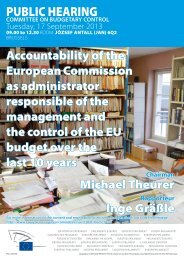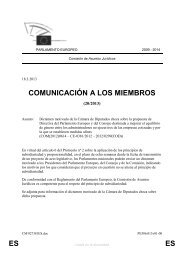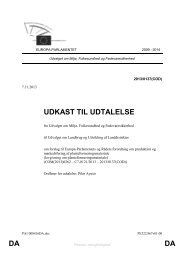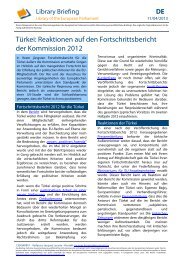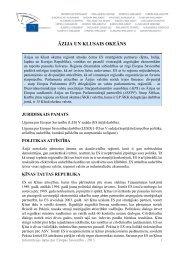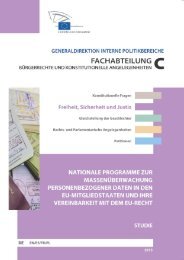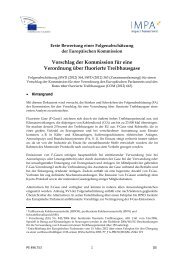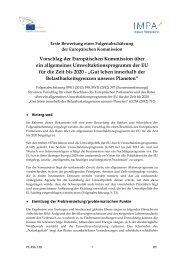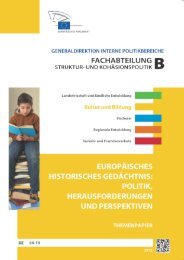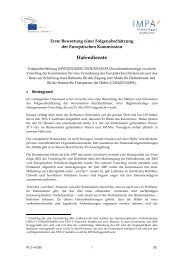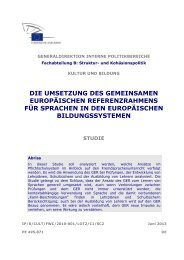Link to the study - European Parliament - Europa
Link to the study - European Parliament - Europa
Link to the study - European Parliament - Europa
You also want an ePaper? Increase the reach of your titles
YUMPU automatically turns print PDFs into web optimized ePapers that Google loves.
Policy Department D: Budgetary Affairs<br />
____________________________________________________________________________________________<br />
Figure 19: Development of work force from 2011 till 2119 and from 2011 till 2021<br />
Source: (NAO 2012)<br />
As can be seen from <strong>the</strong> upper figure ('Long term manpower profile') <strong>the</strong> concept that <strong>the</strong>se numbers<br />
are based on cannot be called a 'safe enclosure period' strategy because of <strong>the</strong> extremely high<br />
employment rates over several decades (until <strong>the</strong> year 2119). It is unclear from those figures what<br />
<strong>the</strong>se many employees shall perform over this very long period. It looks like <strong>the</strong> work is simply<br />
delayed but not structured in conformance with subprojects and work steps. An integration of <strong>the</strong><br />
curves yields roughly 430,000 man∙years in <strong>the</strong> lower case and roughly 560,000 man∙years in <strong>the</strong><br />
upper case. With an average cost figure for wages of £ 50,000/man∙year over <strong>the</strong> whole period, those<br />
wages alone would add up <strong>to</strong> £ 21,500 million (EUR 26,000 million) in <strong>the</strong> lower case and<br />
£ 28,000 million (EUR 33,000 million) in <strong>the</strong> higher case. This indicates that ei<strong>the</strong>r <strong>the</strong> cost calculation<br />
(see chapter 3.3.6) or <strong>the</strong> employment estimate here are inconsistent, differing by more than a fac<strong>to</strong>r<br />
of 100.<br />
One argument for choosing <strong>the</strong> NMP as new Parent Body was that <strong>the</strong>re is <strong>the</strong> chance <strong>to</strong> use <strong>the</strong><br />
expert knowledge available at its parent companies. With this outside expertise <strong>the</strong> performance in<br />
Sellafield was intended <strong>to</strong> be improved. But critics note <strong>the</strong> extremely high costs for <strong>the</strong> external<br />
workforce (House of Commons 2013). In 2011-2012 Sellafield Ltd had 16 executives from its parent<br />
body and NDA reimbursing <strong>the</strong>ir salaries and o<strong>the</strong>r costs, e.g. relocation packages. Between<br />
November 2008 and March 2012 this summed up <strong>to</strong> £ 32 million (NAO 2012).<br />
The parent body NMP also uses specialists known as 'reachback' for e.g. managing critical projects<br />
and programmes. NDA reimburses <strong>the</strong> costs plus an additional 10 % contribution <strong>to</strong> overheads of <strong>the</strong><br />
parent companies. In 2011-2012 <strong>the</strong> <strong>to</strong>tal cost for <strong>the</strong> reachback was £ 17 million. In February 2012<br />
<strong>the</strong> NDA identified decencies in <strong>the</strong> use of reachback resources. This resulted in <strong>the</strong> development of a<br />
reachback deployment strategy (NAO 2012). O<strong>the</strong>r worries concern knowledge management over<br />
<strong>the</strong> long-term since foreign staff normally stays for only 2 <strong>to</strong> 3 years and all undocumented<br />
experience and knowledge gained is lost.<br />
76



